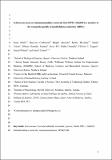| dc.contributor.author | Shiels, Jenna | |
| dc.contributor.author | Cwiklinski, Krystyna | |
| dc.contributor.author | Alvarado, Raquel | |
| dc.contributor.author | Thivierge, Karine | |
| dc.contributor.author | Cotton, Sophie | |
| dc.contributor.author | Gonzales Santana, Bibiana | |
| dc.contributor.author | To, Joyce | |
| dc.contributor.author | Donnelly, Sheila | |
| dc.contributor.author | Taggart, Clifford C. | |
| dc.contributor.author | Weldon, Sinead | |
| dc.contributor.author | Dalton, John P. | |
| dc.date.accessioned | 2020-07-28T09:32:59Z | |
| dc.date.available | 2020-07-28T09:32:59Z | |
| dc.date.issued | 2020-07-09 | |
| dc.identifier.citation | Shiels J, Cwiklinski K, Alvarado R, Thivierge K, Cotton S, Gonzales Santana B, et al. (2020) Schistosoma mansoni immunomodulatory molecule Sm16/SPO-1/SmSLP is a member of the trematode-specific helminth defence molecules (HDMs). PLoS Negl Trop Dis 14(7): e0008470. https://doi.org/10.1371/journal.pntd.0008470 | en_IE |
| dc.identifier.issn | 1935-2735 | |
| dc.identifier.uri | http://hdl.handle.net/10379/16105 | |
| dc.description.abstract | Sm16, also known as SPO-1 and SmSLP, is a low molecular weight protein (~16kDa) secreted by the digenean trematode parasite Schistosoma mansoni, one of the main causative agents of human schistosomiasis. The molecule is secreted from the acetabular gland of the cercariae during skin invasion and is believed to perform an immune-suppressive function to protect the invading parasite from innate immune cell attack.
We show that Sm16 homologues of the Schistosomatoidea family are phylogenetically related to the helminth defence molecule (HDM) family of immunomodulatory peptides first described in Fasciola hepatica. Interrogation of 69 helminths genomes demonstrates that HDMs are exclusive to trematode species. Structural analyses of Sm16 shows that it consists predominantly of an amphipathic alpha-helix, much like other HDMs. In S. mansoni, Sm16 is highly expressed in the cercariae and eggs but not in adult worms, suggesting that the molecule is of importance not only during skin invasion but also in the pro-inflammatory response to eggs in the liver tissues. Recombinant Sm16 and a synthetic form, Sm16 (34-117), bind to macrophages and are internalised into the endosomal/lysosomal system. Sm16 (34-117) elicited a weak pro-inflammatory response in macrophages in vitro but also suppressed the production of bacterial lipopolysaccharide (LPS)-induced inflammatory cytokines. Evaluation of the transcriptome of human macrophages treated with a synthetic Sm16 (34-117) demonstrates that the peptide exerts significant immunomodulatory effects alone, as well as in the presence of LPS. Pathways most significantly influenced by Sm16 (34-117) were those involving transcription factors peroxisome proliferator-activated receptor (PPAR) and liver X receptors/retinoid X receptor (LXR/RXR) which are intricately involved in regulating the cellular metabolism of macrophages (fatty acid, cholesterol and glucose homeostasis) and are central to inflammatory responses.
These results offer new insights into the structure and function of a well-known immunomodulatory molecule, Sm16, and places it within a wider family of trematode-specific small molecule HDM immune-modulators with immuno-biotherapeutic possibilities. | en_IE |
| dc.description.sponsorship | JS was supported by a fellowship provided by the Department for the Economy through Queen’s University Belfast, Northern Ireland, UK. KT, SC, BGS and JPD were supported by a Canadian Institute of Health Research (CIHR) Chair (Tier 1) in Infectious Diseases awarded to JPD (https://cihr-irsc.gc.ca/e/193.html). KC and JPD were funded by the Science Foundation Ireland (SFI, Republic of Ireland) Research Professorship grant 17/RP/5368 (https://www.sfi.ie/). RA, JT and SD were supported by an NHMRC project grant APP1142006 (https://www.nhmrc.gov.au/). CCT and SW are supported by the Medical Research Council, UK (https://mrc.ukri.org/). The funders had no role in study design, data collection and analysis, decision to publish, or preparation of the manuscript. | en_IE |
| dc.format | application/pdf | en_IE |
| dc.language.iso | en | en_IE |
| dc.publisher | Public Library of Science | en_IE |
| dc.relation.ispartof | Plos Neglected Tropical Diseases | en |
| dc.rights | Attribution-NonCommercial-NoDerivs 3.0 Ireland | |
| dc.rights.uri | https://creativecommons.org/licenses/by-nc-nd/3.0/ie/ | |
| dc.subject | Schistosoma mansoni | en_IE |
| dc.subject | immunomodulatory molecule Sm16/SPO-1/SmSLP | en_IE |
| dc.subject | trematode-specific helminth defence molecules (HDMs) | en_IE |
| dc.title | Schistosoma mansoni immunomodulatory molecule Sm16/SPO-1/SmSLP is a member of the trematode-specific helminth defence molecules (HDMs) | en_IE |
| dc.type | Article | en_IE |
| dc.date.updated | 2020-07-27T12:39:13Z | |
| dc.identifier.doi | 10.1371/journal.pntd.0008470 | |
| dc.local.publishedsource | https://doi.org/10.1371/journal.pntd.0008470 | en_IE |
| dc.description.peer-reviewed | peer-reviewed | |
| dc.contributor.funder | Science Foundation Ireland | en_IE |
| dc.internal.rssid | 22009436 | |
| dc.local.contact | Krystyna Cwiklinski. Email: krystyna.cwiklinski@nuigalway.ie | |
| dc.local.copyrightchecked | Yes | |
| dc.local.version | ACCEPTED | |
| nui.item.downloads | 367 | |


